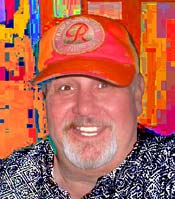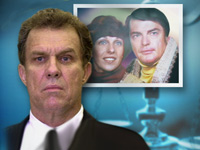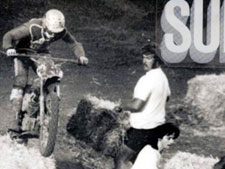
Firko |
Mickey and Mike... Mark Firkin
by Firko #53
January 4, 2007 - The End:
Nineteen years after racing great Mickey Thompson and his wife Trudy were gunned down by masked gunmen in their Pasadena, California driveway, a jury has declared Supercross pioneer Michael Goodwin guilty of the murders.
The verdict came after nineteen years of speculation, two months of testimony and six days of jury deliberation. The jury found the 61 year old former Laguna Beach businessman guilty of both murders. Prosecutors did not call for the death penalty but Goodwin is expected to be sentenced to a life sentence without possibility of parole.
 The Thompson killings had long been one of America’s most infamous mysteries. The case had featured an unprecedented six times on Americas Most Wanted and the news magazine program 48 hours aired two one hour specials dedicated solely to the case. Numerous other television shows, magazine and newspaper articles also helped to raise the cases profile. The Thompson killings had long been one of America’s most infamous mysteries. The case had featured an unprecedented six times on Americas Most Wanted and the news magazine program 48 hours aired two one hour specials dedicated solely to the case. Numerous other television shows, magazine and newspaper articles also helped to raise the cases profile.
Why, in a city where murder is sadly not an unusual occurrence would this case garner so much media attention and grow to become one of the United States legal systems most enduring cases? The answer to that is too easy. The main players in this saga were bigger than life itself and the story, as true as it is, reads like a Hollywood blockbuster.
March 16, 1988 - The Beginning:
It took less than a minute. As Trudy sat listening to the radio news in the idling van, Mickey locked the doors of their rambling Pasadena home and left through the garage to join her. It was just on dawn and the habitual early risers were on their way to work.
Without warning a darkly dressed man stepped out from the morning darkness and fired a shot at Mickey, hitting him in the torso. Thompson staggered a few feet before falling to the driveway. Still alive and obviously aware of what was coming next he cried “Just don’t hurt my wife! Just don’t hurt my wife!”
The shooter then turned towards the van and as Trudy screamed “Don’t shoot, Don’t shoot!” a second gunman shot her through the windshield. The van rolled slowly down the driveway as Trudy either fell or was dragged from it. The first shooter then grabbed her, aimed his gun at her chest and fired a number of rounds into her. The other gunman then went back to Thompson who was crawling towards his wife and peppered him with bullets. The two gunmen then calmly mounted bicycles and rode out of the Thompson estate. By now neighbors had been alerted by the gunshots and screaming and at least one, Lance Johnson had managed to give chase and get a few shots at the assailants with his own gun but the killers were by then too far away.
Neighbors reported seeing two black men dressed in jogging suits ride off on bicycles, a rare sight in the affluent mostly white Bradbury, a gated sub division of Pasadena. The pair pedaled past the unattended security station and into oblivion, never to be seen again.
The only potential piece of evidence left at the scene was a large caliber pistol which was never traced to an owner.
Before we delve into the fascinating machinations of this intriguing case we should look into the histories of the main players, Mickey Thompson and Mike Goodwin.
Both were extremely driven individuals who had achieved success through hard work and innovation. Their eventual meeting was akin to the Titanic and its iceberg. Only one was destined to stay afloat.
Mickey Thompson:
Mickey Thompson was the All American Boy. The son of an Alhambra cop, young Mickey was a pioneer of California’s post WW2 Hot Rod movement. Like thousands of post war kids he lived an American Graffiti lifestyle based around hot cars and girls. It didn’t take Mickey long to move away from the clandestine street racing to proper drag racing and land speed racing at El Mirage and other Mojave desert lakes. From that moment Mickey’s exceptional talents started to shine through.
As a race car driver he was a dominant force in the first NHRA Nationals in 1955 and showed how good he was at early road races at his home track of Riverside. He was the first racer to reach the 150mph barrier in a dragster and was the first driver to hit 400mph on the salt flats in his Challenger 1 streamliner. The moniker ‘King of Speed’ came from his setting of some 500 speed and endurance records.
As an innovator he was credited with developing the first slingshot dragster, the first rear engine Indianapolis car, his amazingly advanced four supercharged Pontiac engined Challenge 1 Land Speed racer, and most importantly, his invention of the treadless racing “slick” that is today not only used in drag racing but in all forms of road racing on both four and two wheels. He was also the first to develop the tunnel ram manifold for V8 race engines as well as too many racing and performance innovations to list. His gift to road safety was his invention of the water filled plastic barrels that are used as crash barriers on freeway exit dividers and other applications. Many of his designs are featured in a permanent display in the NHRA museum.
Thompson’s racing career was marked by a number of tragedies. In the infamous 1953 Mexican Road Race he lost control of his car and barrel rolled into a group of spectators, killing five and injuring many more. At the 1964 Indianapolis 500 his driver Dave MacDonald was incinerated in a first lap crash that also took the life of veteran Eddie Sachs. Thompson himself was temporarily paralyzed in one of two big power boat racing accidents. He never fully recovered from that injury and suffered severe back pain until his death.
In the late ‘60s Mickey became interested in desert racing and would spend the rest of his life earning a living from it and its offshoots. He formed the SCORE sanctioning body in the early ‘70s and as a driver his biggest win came in the 1982 Baja 1000. Having seen how successful Supercross had become he came up with an idea that the excitement of desert racing would translate well to a stadium environment. He formed the Mickey Thompson Entertainment Group (MTEG) and started a national series. The rough and tough indoor courses featured car crushing bumps and jumps that opened up the world of off road racing to a whole new market.
In 1984 Thompson had the first of a number of meetings with Supercross promoter Mike Goodwin with the intention of forming a partnership. Mickey’s back was not getting any better and Trudy had bad knees so they were looking at lessening their work load. Friends of both Thompson and Goodwin warned them that such a partnership would only end in disaster. It was obvious to many observers that both of these forceful egos would clash immediately. Nonetheless, On April 1, 1984 Goodwin merged his Stadium Motorsports Corporation (SMC) with Thompson’s MTEG into a partnership calling for a split ownership and operating expenses at 70% for Goodwin and 30% for Thompson. The
pit bulls were now circling in the pit.
 Mike Goodwin: Mike Goodwin:
Like Mickey Thompson, Mike Goodwin was also a product of Southern California’s post war prosperity. Growing up in suburban San Diego, the son of a US Navy Admiral, young Mike quickly discovered he had the knack of making a buck. While at college he noted that the Rolling Stones weren’t visiting San Diego on their US tour. Seeing this as an opportunity to make some money and raise his business profile, he approached the tours management with his plan for a concert in San Diego. Surprisingly the rookie promoter got a yes answer and with money borrowed from friends and family managed to promote that concert with outstanding success. He went on to promote concerts by big artists like Janis Joplin to the Doors, the Grateful Dead and the Who.
While all of this was happening Mike raced motocross and as it was his first love he wondered how he could make rock’ n’ roll style money out of the then grass roots sport. The idea that spawned of the birth of Supercross came when he and his future wife Diane had gone to the USGP at Carlsbad. To most guys sitting in the sun drinking beer and watching motocross is heaven but to Diane it was a living hell. The heat, flies, dust, lack of parking and worst of all, lining up to visit an overflowing, stinking porta-can took their toll on Diane to the point that she threatened to leave him if he ever took her to another motocross race. That experience planted a seed in Goodwin’s fertile mind.
Goodwin had been friendly with Los Angeles Coliseum manager Bill Nicholas through Bills son who raced with him. Over a few drinks at a bar adjacent to the Coliseum Goodwin pitched the idea of holding a motocross race in the famous old stadium. Nicholas loved the concept and stated to Goodwin “You give me a monster cleaning deposit, bring in the dirt and let’s go for it”. The rest is history. That first race, dubbed the Superbowl of Motocross was held later in 1972.

Mike Goodwin (white shirt) works the
infield at the ’72 Superbowl of Motocross |
To promote the event, Goodwin bought rock concert style advertising blocks for airing at drive time on LA rock stations like then top rating KMET. It worked a treat and an impressive crowd of mostly newcomers eager to see what this motocross thing was all about had a ball watching unknown sixteen year old San Diego racer Marty Tripes beat a bevy of European champions to win on a Yamaha. In 1973 Goodwin introduced the now legendary ski jump where the track was extended up into the stands and the riders had to jump 100 feet back into the stadium proper. That event spurred on by non stop radio advertising spruiking the big jump, had twice the previous year’s spectators, almost filling the available seating.
By 1977 Goodwin was living the Hollywood lifestyle he’d always dreamt of with exotic cars, a big house on Laguna Beaches exclusive Skyline Drive and lots of sex and drugs and rock’ n’ roll. He loved publicity, no matter how good or bad it was and the media loved him. But as wild as his life had become, he was still a brilliant businessman who gave sponsors and the fans exactly what they wanted, and more. The business went from strength to strength with the 1979 event attracting an all time
Supercross record of nearly 80000 fans. He made $660 000 profit on that one event alone.
Many would be promoters saw the success that Goodwin had achieved and jumped on the bandwagon, more often than not failing. Despite his own success and innovation, Mickey Thompson was one of those promoters who saw the money to be made and knew the game well. Sadly however he was about enter into a relationship that could never have a happy ending.
Next month... It all gets ugly. Goodwin goes on the lam.
***
|




 The Thompson killings had long been one of America’s most infamous mysteries. The case had featured an unprecedented six times on Americas Most Wanted and the news magazine program 48 hours aired two one hour specials dedicated solely to the case. Numerous other television shows, magazine and newspaper articles also helped to raise the cases profile.
The Thompson killings had long been one of America’s most infamous mysteries. The case had featured an unprecedented six times on Americas Most Wanted and the news magazine program 48 hours aired two one hour specials dedicated solely to the case. Numerous other television shows, magazine and newspaper articles also helped to raise the cases profile. Mike Goodwin:
Mike Goodwin:
